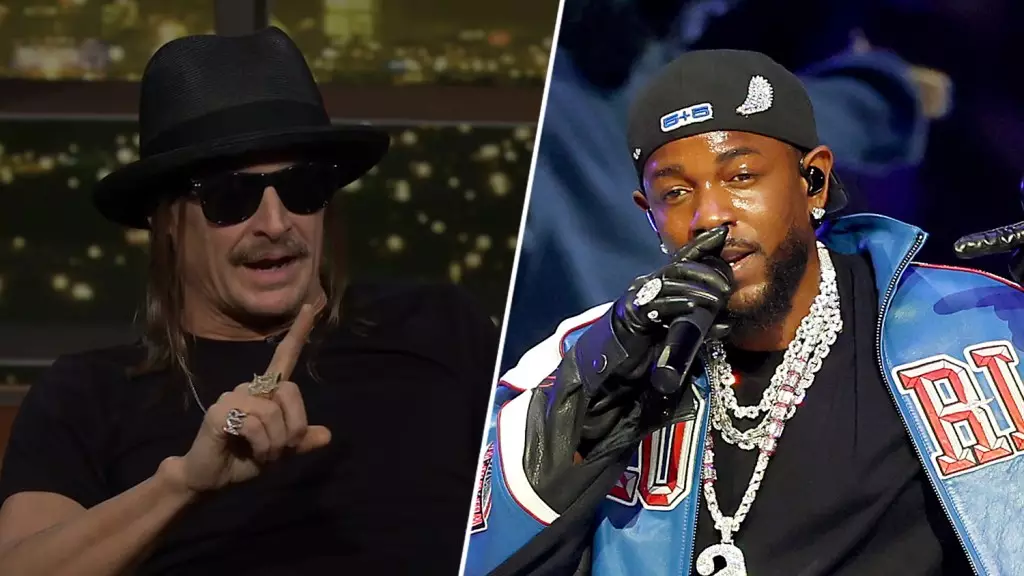Kendrick Lamar’s halftime show during the Super Bowl was a spectacle that resonated with many, yet garnered a surprising reaction from Kid Rock that left viewers perplexed. Analyzing Rock’s remarks provides a fascinating lens through which to assess hip-hop culture, race relations, and the very fabric of American entertainment. His comments, shared on the talk show “Real Time with Bill Maher,” reflect a complex and often convoluted relationship with cultural expression.
Kid Rock’s attempt to position himself as an authority on hip-hop culture serves as the crux of his commentary. He presents himself as someone who has “understood the culture” due to his personal experiences with hip-hop, including breakdancing and DJing. This assertion, however, raises a fundamental question about authenticity and cultural appropriation. Rock’s narrative of emulating hip-hop stands in stark contrast to the realities faced by Black artists like Kendrick Lamar, who occupy a space steeped in personal and collective histories of struggle and triumph.
His statement that Lamar’s performance was an “unapologetic” display of artistry brings to light the divergences between how artists of differing backgrounds perceive expressive freedom. While Rock finds merit in Lamar’s potential disregard for mainstream approval, one must consider whether this viewpoint underplays the complexities of Lamar’s lived experiences and the cultural commentary that permeates his work. To frame Lamar’s performance as simply an affront to mainstream norms dismisses the deeper conversations about race, representation, and acceptance in American society.
A pivotal element of Rock’s reaction hinges on his framing of diversity, equity, and inclusion (DEI)—a term that has gained significant traction in recent years. His characterization of Lamar’s performance as the “epitome of DEI blowing up” appears to misunderstand the effectiveness and objectives of DEI initiatives. By arguing that the performance lacked white individuals, Rock implies a troubling notion that diversity can only be valid with the presence of white representation, instead of recognizing that true diversity embodies the strength and uniqueness of various cultures on their own terms.
In attempting to align Kendrick Lamar’s presence at the Super Bowl with discussions surrounding DEI, Rock inadvertently illustrates the resistance against the very principles he seems to critique. Kendrick’s show, filled with Black artists and cultural references, does not seek validation from wider audiences; rather, it creates a space where Black identity is affirmed and celebrated. Here, Rock’s misunderstanding of the intention behind Lamar’s performance reveals a broader societal struggle with embracing cultural authenticity in multiethnic contexts.
Another notable component of Rock’s statements is his assertion that Colin Kaepernick’s protests played a crucial role in shaping the context of the Super Bowl and Kendrick’s involvement. This connection dives into an essential dialogue about sports as activism. Kaepernick’s kneeling during the national anthem sparked a nationwide conversation around racial injustice, fundamentally altering the landscape of the NFL and providing artists like Kendrick Lamar a platform to express their realities.
Rock’s suggestion that both Kendrick and Jay-Z should thank Kaepernick with celebratory gifts reflects a reluctant acknowledgment of how activism can dramatically shift cultural narratives. Yet, it also raises questions about how mainstream figures within entertainment engage with and support movements centered around social justice. Acknowledging Kaepernick’s influence necessitates grappling with the historical silence and inaction from many in Rock’s own sphere of influence.
Ultimately, Kid Rock’s reaction to Kendrick Lamar’s halftime performance highlights the ongoing tensions in America’s cultural landscape, particularly regarding race and representation. His comments signify a profound misunderstanding of both the cultural essence of hip-hop and the implications of authentic representation in diverse environments. Instead of fostering a constructive dialogue about the intersections of race, culture, and performance, Rock’s critique can often feel dismissive of the very real narratives that artists like Kendrick Lamar seek to convey.
In exploring these dynamics, we begin to see that the conversation around cultural expression is not merely about performance, but rather an essential dialogue on identity, recognition, and the transformative power of media in shaping societal views. Through Lamar’s unapologetic artistry, there lies an invitation for broader, deeper discussions—if only individuals are willing to engage with the complexities that define them.

